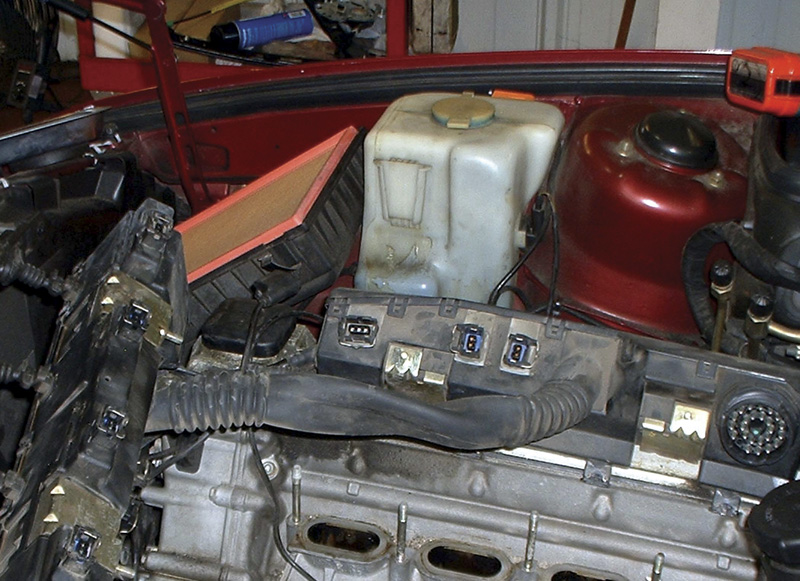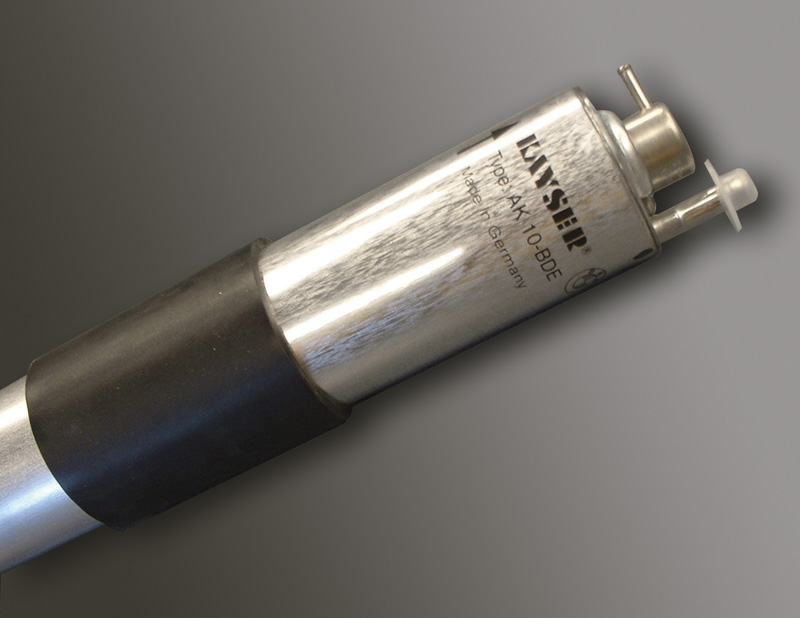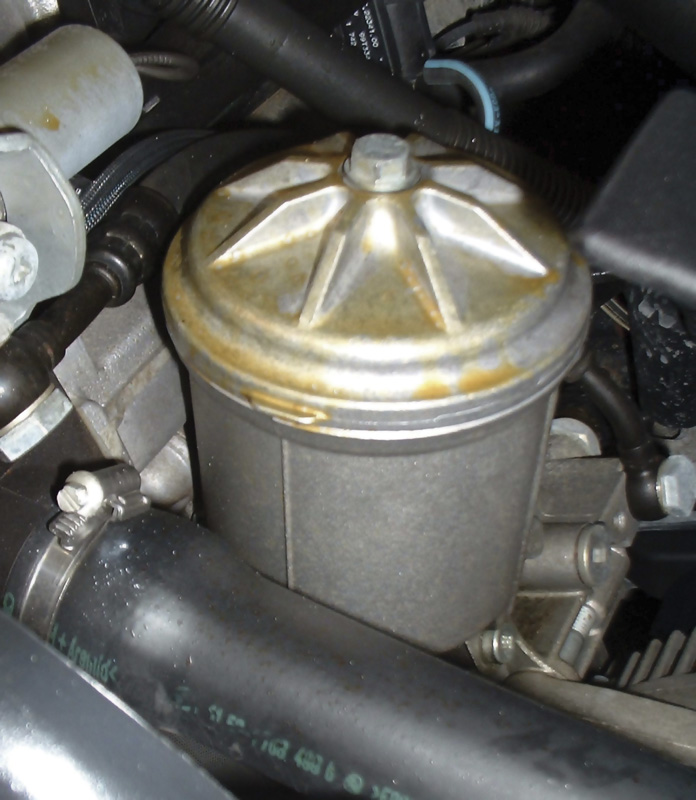
Performing regular fluid and filter maintenance is the single most important thing you can do to ensure that your customers enjoy their BMWs for as long as they like.
Despite its critical importance, most shops consider fluid and filter changes to be “low-tech.†However, when you know more about BMW filters, you will understand that the “low-tech†replacement procedure reflects the very high-tech engineering that goes into designing and making modern filters. And, if you take just a few extra seconds to examine the old and new filters and interpret the results, you raise the skill level of filter replacement considerably.
In engineering terminology, filters don’t “prevent contamination,†they provide “contamination control.†A perfect filter would allow all the air or liquid to pass through unrestricted for maximum efficiency, while blocking all contaminants for maximum protection. But no filter can provide 100 percent efficiency and 100 percent protection.
Think about a one-cylinder, fuel-injected engine that has a straight section of pipe for an intake manifold. If the pipe is open, airflow is 100 percent efficient because nothing restricts air movement into the engine. But protection is zero because there is nothing to block any airborne contaminants.
Cover the pipe and protection goes to 100 percent because nothing can get in. But efficiency drops to zero because the engine can’t run either—there is no air available.
In addition to efficiency and protection, filters are also rated by capacity, or the volume of contaminants a filter can hold before it becomes overloaded. The greater the capacity, the longer the service interval.
Premium grade filters, like BMW’s, incorporate proprietary media, unique flow design, and quality construction for optimal levels of efficiency, protection, and capacity. Discount filters typically cut corners on media, flow design, and construction so they cannot match the service levels of a premium filter.
Before getting into the specific filters, there are some basic procedures you should follow when replacing any filter.
- Determine how long it has been since the last filter change, according to your shop records, or the owner’s maintenance records.
- Compare the condition of the old filter to the time and mileage indicated on the records. If the car is at its proper scheduled service interval, but the filter is very dirty, your customer’s driving is probably in the “severe duty†category. Recommend more frequent service intervals to your customer because of his or her driving pattern.
- If the filter is very dirty and the car has not been serviced in a long time, advise your customer on the importance of sticking to BMW’s recommended service intervals. If your shop has a customer reminder program, verify the customer’s current contact information and update your reminder system records.
- If the filter isn’t excessively dirty, but the service internal is overdue according to your records, your customer may be getting service work done else where. If the old filter isn’t from BMW, you know for sure the customer is going elsewhere. It’s time for some serious customer relations to promote your shop and its ability to provide the best possible service for your customer’s BMW.
Air filter

Whenever you are doing major engine work, such as this intake manifold gasket replacement job, wouldn’t it be foolish not to replace that air filter?
Air filters work hard. True, air filters are not exposed to the temperatures and/or pressures that fuel filters, oil filters, and transmission filters face. But in terms of volume, air filters work the hardest because burning a gallon of gasoline in an internal combustion engine uses about 10,000 gallons of air! And every gallon of air passes through the air filter before it enters the engine.
Air filters must capture dust, pollen, soot, carbon, sand, and other airborne contaminants. If these contaminants were not captured, they would cause internal engine wear. The standardized SAE test for air filters requires a mixture of contaminants, ranging in size from 0 to 80 microns, to enter the filter. The filter capacity is calculated on the total volume of contaminants the filter holds before becoming too clogged to provide sufficient airflow to the engine.
Premium air filters are designed to be especially effective at capturing 10 to 20 micron size particles because these particles have been shown to cause the fastest, most severe engine wear.
New air filters are “oversized†with excess capacity. A new filter can hold contaminants while still allowing as much airflow as the engine needs. When changed at the recommended service interval, the filter should still be able to meet maximum airflow needs, despite the contaminant load. However, if kept in service too long, or exposed to unusually high levels of contamination, the contaminant load will begin to restrict airflow. The reduced airflow causes a drop in overall performance, especially full-throttle acceleration.
When replacing an air filter element, inspect the old one. If it is excessively dirty, it usually means your customer is not sticking to BMW’s recommended service internal. In rare cases, an excessively dirty air filter means the car has been exposed to very high levels of contamination—ask your customer where he or she has been driving. Desert areas during sand storms? Regardless, if this is a chronic condition, recommend more frequent service intervals.
Before installing the new filter, check the air box to make sure there are no dents, cracks or other damage. And look at the filter to make sure it is OK. Never install a filter that has any sign of a defect. Wipe the air box clean, seat the new filter, and secure it. The air box fasteners should be snug, but not difficult to secure.
Oil filters
The BMW onboard engine oil monitoring system that was first introduced on some models in 1999 makes it easy to tell when oil and filter changes are needed. But if your customer’s BMW doesn’t have the oil monitoring system, and especially if he or she drives in severe conditions (city traffic, trailer towing, etc.), take time to review the situation and recommend an oil service interval that provides adequate protection for that particular car.
According to a survey done by a member company of the Filter Manufacturers Council, only about 20 percent of vehicles are regularly driven under “normal†conditions. The remaining 80 percent—4 out of 5 cars on the road—are driven under “severe†conditions. Even aggressive BMW drivers might think they are “normal†drivers because BMWs are meant to be driven hard.
Your customer is probably in the severe category if he or she:
- Frequently takes trips that are less than four miles, which do’t allow the engine adequate time to warm up and reach a desired operating temperature.
- Spends a lot of time idling. And remember that idling doesn’t just mean having the car stopped and the engine running. It also includes stop and go driving.
- Does long-distance, high-speed driving when air temperatures are high, typically summertime vacation driving.
- Does a lot of driving on dirt, sand or gravel roads, or in areas when there is a high level of dust.
The media in a BMW oil filter does an excellent job of balancing protection and efficiency. The media will capture 98%+ of all particulate matter, but without causing excessive backpressure. Anytime a fluid must flow through a filter, there is some backpressure — it cannot be avoided. But BMW filters keep the backpressure so low it doesn’t interfere with the lubrication system.

. . . or the newer plastic type, BMW’s cartridge oil filters are especially easy to service. They’re always in an accessible location.
For several good reasons, late-model BMWs use cartridge-type oil filters. In other words, the filter housing is permanent, and only the element is disposable. Typically, the cartridge is located in an easy-to-reach spot, too, so a filter change is easy. Just remember to always replace the O-ring.
Some older BMW models, however, use the spin-on oil filter, which has a lot of technology in a relatively small package. Oil enters the center of the filter, passes through a specially designed filter media, and then reenters the lubrication system. As the oil passes through the filtering media, any particles suspended in the oil are trapped to prevent them from returning to the engine.
As long as the filter is changed regularly, backpressure is normally not an issue. However, if the oil filter is kept in service too long, it becomes loaded with contaminants and backpressure begins to build. Eventually the filter can become so clogged, little or no oil can flow. Operating on the principal that dirty oil is better than no oil, filters have a bypass valve that opens when backpressure becomes too great. This allows unfiltered oil to flow, maintaining adequate oil pressure in the engine.
It is extremely important to note that some BMW oil filters incorporate an anti-drainback valve to keep the filter filled with oil after the engine is shut off. If you were to buy an aftermarket replacement filter without this valve, the bearings would be starved for oil at start-up, resulting in rapid wear and eventually a rod knock. That’s yet another reason to buy Original BMW Parts.
Replacing an oil filter is a simple task, but you should include several checks to identify and head off possible problems.
- Look at the old filter before you remove it. Is it bulging or otherwise deformed? A bulge means there is excessive oil pressure, normally caused by a faulty oil pressure regulating valve in the oil pump. Test the oil pressure and if it is high, the pump must be replaced.
- Is the old filter dented? A dent means that either a damaged filter was installed the last time—which should never be done—or something struck the filter. Inspect the area around the filter to see if there are any other signs of damage from the car hitting something.
- Carefully remove the old filter. Wipe the mounting surface on the engine with a clean rag. Inspect the mount for damage. And make sure the gasket from the old filter hasn’t come off and stuck to the engine. Remove it if it is still in place.
- Look inside the old filter, is the center tube deformed? A bad center tube is not always visible, but if the tube is deformed, there is a chance that filter media or other pieces of the oil filter have entered the engine which can cause big problems. Test the lubrication systems to make sure oil pressure is within normal range and listen for any noises that indicate internal wear problems.
- Typically, a center tube will be deformed because the filter by-pass valve or the oil pressure regulating valve malfunctioned due to using oil that was too thick in cold weather conditions, excessively contaminated oil, bits of carbon or other “hard†contaminants temporarily jamming a valve, excessive “racing†or hard acceleration with a cold engine.
- Before installing the new filter, inspect it to make sure there are no dents or other signs of damage and that the gasket is securely attached. Never install a new filter that has any sign of damage.
- Apply a light coat of engine oil to the gasket and install the filter. When the gasket starts to seat, tighten the filter another quarter turn (90 degrees). Do not over tighten.
- Drain the old oil filter and dispose of it in compliance with all regulations.
Fuel filters

With a fuel filter as sophisticated as this and with such a huge capacity, it would probably be unwise to replace it with anything but the original BMW part.
The job of a fuel filter has gotten much harder than “back in the day†of seven psi mechanical fuel pumps feeding 35-cents-per-gallon gasoline to a carburetor. High-pressure, high-volume fuel injectors require a fuel filter that can handle much higher pressures and capacities, and also do a much better job of removing particulate material. The same piece of dirt or other contaminant that an old carburetor could have “swallowed†without a problem would jam a modern fuel injector.
On late-model BMWs, the fuel filter does double duty. In addition to working as a conventional filter, its large size makes it a fuel reservoir that dampens fuel pump pulsations. Fuel flow is smoother and steadier as it leaves the filter and travels to the fuel rail and injectors.
Fuel contaminants include dirt, rust, other debris, and water. These contaminants can be external—coming from somewhere in the fuel supply infrastructure. They can also be internal, caused by fuel tank corrosion as a vehicle ages. Since BMW started replacing metal fuel tanks with plastic tanks years ago, internal fuel system contamination has been vastly reduced.
A clogged fuel filter will make itself known by deteriorating engine performance, gradual loss of power, bucking and stalling during acceleration. In the case of a totally clogged filter, there will be no performance at all because not enough gasoline will get through for start-up. Always inspect a clogged filter and try to determine if the contamination is coming from an aging fuel tank or from outside the car. You can use a pipe cutter to open the old filter and inspect the contents.
There is little, if anything, you can do about external contamination, except to suggest that your customer purchase fuel from a different station. If the contamination is coming from the tank, say in an old model BMW, the only solution is to drop it and flush it, or replace it.
Cabin filters
If your customer’s BMW is a 1999 or newer model, odds are it has a cabin filter. And if it is a 2003 or newer, then it certainly has a cabin filter. In 1999, BMW had these on 90% of its new cars. Four years later, all BMWs came with cabin filters. This development represents a new and promising profit opportunity for you.
Surprisingly, cabin filters aren’t new. The first recognized use of a passenger air filter system was in the 1939 Nash “Weather Eye†system. But the idea didn’t really catch on — Nash still went out of business.
Cabin air filters did not return to the automotive scene until the mid-1980s when deteriorating air quality became a major issue in Europe. BMW realized that its engines were breathing cleaner air than its customers!
Today’s cabin filters do an excellent job of removing smoke, dust, bacteria, mold spores, pollens, and some exhaust gas residues like toluene and n-butane. The filters also help protect the blower motor and other components on the BMW heating and air conditioning system.
Surprisingly, despite the near universal use of cabin filters, many BMW owners don’t even know they have one. And if they don’t know they have a cabin filter, then they certainly don’t know that it is probably overdue for a change. The recommended replacement interval is 12,000 to 15,000 miles, or annually, whichever comes first, unless the car is driven in a very dusty or otherwise contaminated areas.
Signs that a cabin air filter is clogged or failing include reduce air flow from the heating/AC system and a musty smell inside the car, especially when the heater or A/C is running. But those are signs of a filter long over due for replacement, like poor performance is a sign that an engine air filter has been in there too long.
Selling replacement cabin filters should be fairly easy when you explain that it protects the customer himself, not his car. It represents a direct, personal benefit. As a powerful visual aid, keep a dirty cabin filter handy so you can show your customers what he or she is protected against. Also, keep the old element to show the customer that his or her money was well spent.
Whenever you promote any filter replacement, don’t just treat it as a “low-tech†job, even though filter replacement is easy to do. Instead, sell the job in terms of benefits to your customers and to their BMWs. Regular filter changes will allow them to keep driving their BMWs for many, many miles, which means they will be your customers for a long, long time.



0 Comments